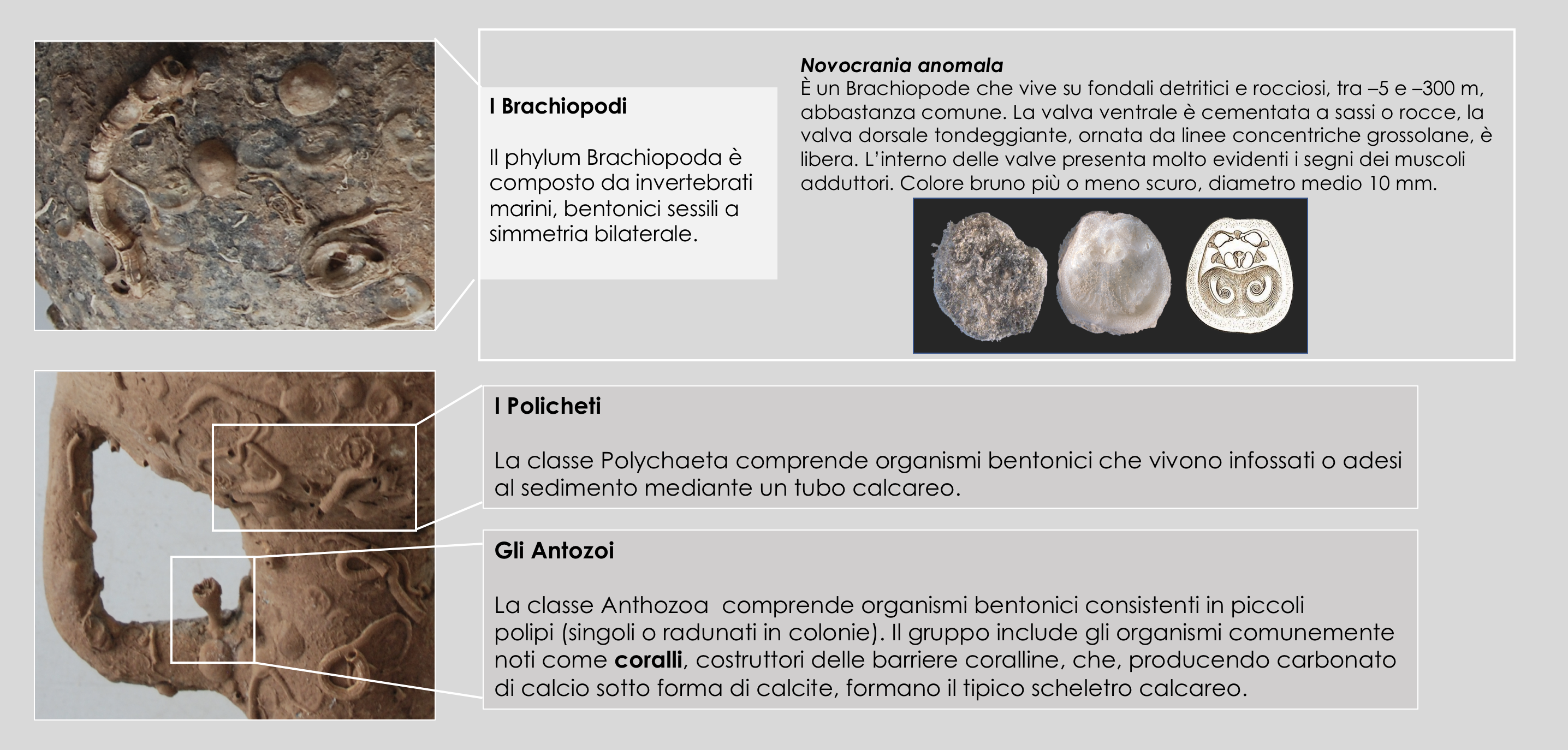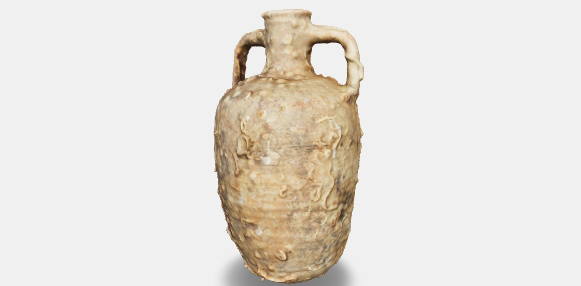The shape evolved considerably between the IV and the VII century A.D. (PIÉRI, 2005; REYNOLDS, 2005). Its first specimens can be traced back in the mid-III century A.D.
In the first half of the V century A.D. LRA1 (Late Roman Amphora 1) was initially exported on a large scale to the Western ports of the Mediterranean, for the troops deployed on the Lower Danube and to Alexandria (EGLOFF, p. 169). In this particular phase, it had a shorter neck with a prominent truncated-conical shape, the rim indistinct from the wall, a wider shoulder and a right-angle handle profile. During the second half of the V century A.D., the neck becomes wider and more cylindrical. The bottom has a small sign of umbonation. At the end of the V century A.D., the body is still pear-shaped.
The specimens from the VI century (EGLOFF, p. 164) differ in having a more cylindrical shape and a rounded base. The neck is still cylindrical. The handles are big and thick. The walls show marked and convex grooves. The rim of a LRA1 from the V till the VI century A.D. may be irregular, despite the care with which the rest of the body was crafted. The Cypriot specimens are a perfect example of this inaccurate fabrication of the rim.
Dating
From the mid-III century till the mid-VII century A.D. However, the ‘classic’ LRA 1 (EGLOFF, p. 169) dates back to the beginning of the V century and its immediate predecessor (with a narrow neck) is recognizable since the mid-IV century A.D.
The last specimens of this type were found in contexts dating back to the second half of the VII century A.D. (Crypta Balbi in Rome and Alexandria).
Origin
LRA1 was produced in the Roman provinces of Cilicia and in Cyprus. A number of furnaces were dug in coastal sites of these locations (EMPEREUR, PICON, 1989; DEMESTICHA, MICHAELIDES, 2001; DEMESTICHA 2003). All the furnaces producing LRA1 found in Cyprus seem to have been active only between the VI and the VII centuries A.D. The evidences for their production in Roman Syria are not definitive. Reynolds (2005a) suggested that the sites of production were to be located in Seleucia and Arsuz.
Distribution
Between the beginning and the first half of the III century, some specimens were exported to Beirut and Sinai. In these areas, types from the mid-IV century A.D. can also be found. The end of this century documents a major distribution of this shape, especially in the areas located towards the Black Sea and the fortresses in the Lower Danube.
The first major exports in the whole Mediterranean, the Aegean and the Black Sea can be traced back to the beginning of the V century A.D. They reached the Atlantic Great Britain between the late V and mid-VI centuries A.D. LRA1 is the most common type of amphora imported from the Eastern Mediterranean in the majority of Mediterranean sites (e.g. Beirut, Carthage, Marseille and Tarragona; see REYNOLDS 1995; 2005b). In the Aegean Sea it is often found together with LRA2.
Content
Both wine and oil were assumed. According to Piéri (2005), wine was the main content.
The amphora presents a dense epilithic colonisation on its entire surface. The biogenic encrustations are well preserved and attributable to various groups of organisms, shells and calcareous coatings. In particular, there is a rich proliferation of sedentary Polychaeta, recognizable as whitish calcareous tubes of various dimensions and shapes. The calcareous shells of Brachiopoda, often with two valves and rounded, are widespread. The third component of bioconcretion is represented by colonies of Bryozoa, visible as thin fouling layers, often overlaid or covered by other bioconstructors. Close to the handle, there is an isolated anthozoan. The presence of these animals, in particular of Brachiopoda, provides us with useful information about the conditions in which the artefact was positioned: it is known that Brachiopoda, in fact, prefer sciaphilous environments and thus is able to live in poorly lit environments (caves or hollows) or at great depths. Their presence on the surface of the artefact indicates with all certainty that the artefact exposed all its surface to the water column over time, favouring such colonisation. All the aforementioned organisms colonised the artefact only on its surface, as pottery, for its nature, is not subjected to endolithic colonisation.

REFERENCES
Demesticha, S. 2003, Amphora production on Cyprus during the Late Roman period, VIIème congrès international sur la céramique médiévale en Méditerranée. Thessaloniki, 11-16th October 1999, pp. 469-476
Demesticha S., Michaelides D. 2001, The excavation of a Late Roman 1 amphora kiln in Paphos, in La céramique Byzantine et proto-islamique en Syrie-Jordanie (IVe-VIIIe siècles apr. H.-C.), Actes du colloque tenu à Amman, Institut Français d’Archéologie du Proche-Orient, Bibliothèque Archéologique et Historique, 159, pp. 289-296
Egloff, M. 1977, Kellia III. La poterie copte: quatre siècles d’artisanat et d’échanges en Basse-Egypte, Geneva
Empereur J.Y., Picon M. 1989, Les régions de production d’amphores imperiales en Méditerranée orientale, Amphores romaines et histoire économique: dix ans de recherche, in Actes du colloque de Sienne (22-24 mai 1986). Collection de l’École Française de Rome, 114, pp.223-248
Piéri, D. 2005, Le commerce du vin oriental à l’époque Byzantine, in Bibliothèque d’Archéologie et d’Histoire, Institut Français du Proche Orient, Beirut
Reynolds, P. 1995, Trade in the western Mediterranean, AD 400-700: the Ceramic evidence, inArchaeopress , British Archaeological Reports International Series, Oxford
Reynolds, P. 2005b, Hispania in the late Roman Mediterranean: ceramics and trade, in Hispania in Late Antiquity: Twenty-first century approaches, Leiden



